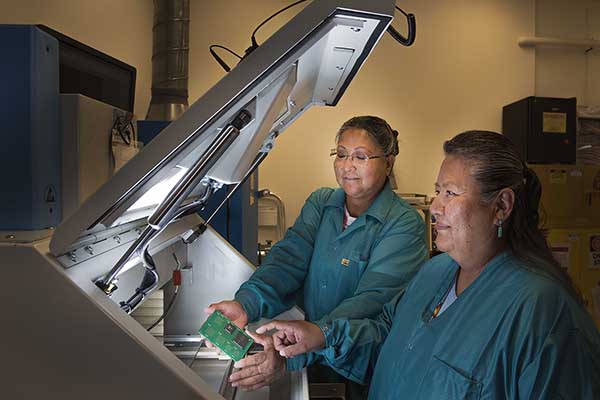Upgraded, expanded Light Electrical Lab provides Sandia with in-house expertise for tiny electronics
As an 8-year-old girl herding sheep on the Navajo Nation, Etta Tsosie (5346) found a discarded radio and fixed it by installing a scavenged diode.
“My first soldering iron was a butter knife,” says Etta, remembering how she managed to insert the diode.
From that auspicious beginning, Etta studied electronics at TVI (now CNM), worked in electronics before joining Sandia as a custodian, and then assembled parts for neutron generators. Eventually, she took a job in Sandia Center 5300’s Light Electrical Lab and, with electronics technologist Maxine Norton (5346), has advocated for its now-completed upgrade and expansion.
“It was so crammed in here that we couldn’t use the machinery,” Etta recalls.
Space is no longer an issue in Bldg. 891, Lab 1071B. The improved lab has about double the floor space and new equipment to take its work to the next level. The lab handles tiny, even microscopic, electronics components, including custom-built components that must survive in extreme environments, like outer space.
The new equipment includes:
- an ERSA PL 650 Rework System that can penetrate thicker circuit boards and is used to inspect electronics or fix them.
- a Verifier HR130 X-ray machine used to look for moisture, air pockets as small as a speck of dust, or areas where solder is missing. Such anomalies can cause the board to malfunction, Maxine says.
- a Cascade TEK Forced-Air Oven used to bake moisture out of components.
- a Lumenera Optic 2 Camera.
The two technologists say the upgrades can save scientists and engineers time and money.
Etta, who began her career with the Labs’ custodial staff in 1986, has worked in the Light Electrical Lab since 2000 and has seen her skills help with many successes, including work on the laser dynamic range imager for NASA’s space shuttle program and robotics.
When a printed circuit board on Sandia’s Miniature Autonomous Robotic Vehicles was short-circuiting as a certain part was attached, Etta says she found out why. She discovered an exposed vertical interconnect access, or via, an electrical connection between layers in an electronic circuit. She covered the exposed electronics and soldered the component on top to fix the problem.
Years later, she says, she was delighted to hear the Smithsonian Institution requested the robots for its permanent collection.

LAB EXPANSION — Maxine Norton, left, and Etta Tsosie (both 5346) work on electronics in a newly expanded section of the Light Electrical Lab. The now-completed upgrade doubled the lab’s floor space, making room for new equipment to take their work to the next level. The lab serves all Sandians. (Photo by Randy Montoya)
A quick turn-around
Each year, the lab serves an average of 90 customers from different organizations at Sandia, Etta says, adding the lab is open to all organizations at the Labs that need its help.
Maxine, who worked as an OAA for many years, switched to the technical side by joining the Light Electrical Lab and is currently studying for her associate’s degree in systems technology.
Etta, who is planning to retire after 30 years at Sandia, is mentoring Maxine in her new role. Both technologists have Class 3, or high quality level, certifications.
The jobs the technologists can perform include visual inspections of populated printed circuit boards and printed wiring boards, adding components to both types of boards, installing or replacing ball grid arrays (BGAs), X-rays, modifications of boards or parts, repairs, conformal coating, cleaning boards, cleaning during operations, and inspections.
Anthony Ernest (5332), a microwave and sensor engineer, says he relies heavily on the lab’s expertise when validating prototypes for defense projects, working with BGAs, designing components to survive extreme environments, and other tasks. Often he works side-by-side with Etta and Maxine to troubleshoot, and the lab has a quick turnaround, he says.
“Their expertise definitely enables our group to deliver,” Anthony says. “For many flight tests we’ve had, they’ve been instrumental to our success.”
The best of both worlds
Both women enjoy seeing programs achieve success due to their work and they are happy they could pursue careers as technologists.
“I have the best of both worlds: to be in the program at school and learn the technical jargon and to be hands-on at my job,” Maxine said.
When Maxine was researching to become a technologist, she remembers Etta using the analogy of having experience silversmithing. Etta thought some Native Americans are naturally good at soldering because of that. “To me, it’s an art, a craft that I do,” Etta says. “Everyone always asks me whether I love my job, and I say, ‘Yes, I love my job. This is what I always wanted to do.’”